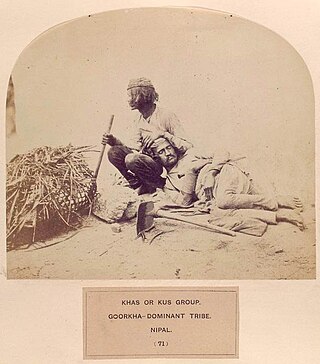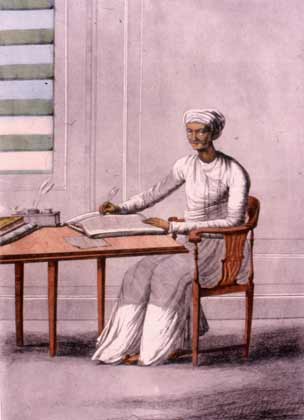
Brahmin is a varna as well as a caste within Hindu society. In the Vedic- and post-Vedic Indian subcontinent, Brahmins were designated as the priestly class, serving as priests and spiritual teachers. The other three varnas are the Kshatriya, Vaishya, and Shudra.

Dalit, also some of them previously known as untouchables, is the lowest stratum of the castes in the Indian subcontinent. Dalits were excluded from the four-fold varna of the caste hierarchy and were seen as forming a fifth varna, also known by the name of Panchama. Several scholars have drawn parallels between Dalits and the Burakumin of Japan, the Baekjeong of Korea, the Hukou system of China and the peasant class of the medieval European Feudal system.
Saraswat Brahmins are Hindu Brahmins, who are spread over widely separated regions spanning from Kashmir in North India to Konkan in West India to Kanara and Kerala in South India. The word Saraswat is derived from the Rigvedic Sarasvati River.
The Other Backward Class (OBC) is a collective term used by the Government of India to classify castes that are educationally or socially backward. It is one of several official classifications of the population of India, along with general castes, Scheduled Castes and Scheduled Tribes (SCs and STs). The OBCs were found to comprise 52% of the country's population by the Mandal Commission report of 1980 and were determined to be 41% in 2006 when the National Sample Survey Organisation took place. There is substantial debate over the exact number of OBCs in India; it is generally estimated to be sizable, but many believe that it is higher than the figures quoted by either the Mandal Commission or the National Sample Survey.

Khas tribe, popularly known as Khashya, according to the 2015 constitution of Nepal are an Indo-Aryan ethno-linguistic group native to the Himalayan region of the Indian subcontinent, in what is now the present-day South Asian country of Nepal, as well as the Indian states of Uttarakhand, West Bengal and Sikkim. Historically, Khas were the speakers of an ancient Khas language from the Indo-Aryan language family and the earliest recorded speakers of the Western Pahari languages. The large portion of the Indo-Aryan speakers throughout lower Himalayas were the Khas people. An intrusion of this tribe from the Western and Northwestern Himalayas into Central Himalayas is substantiated by the early linguistic evidences related to the Nepali language. They were also known as Parbatiyas/Parbates and are currently known as Paharis/Pahadis.. They were also referred to as Yartse in Tibet and are also known as Khasan by Bhotia people. The term Khas has now become obsolete, as the Khas people have adopted communal identities because of the negative stereotypes associated with the term Khas. In Nepal the native speaker of Nepali language are known as Khas.
Deshastha Brahmin is a Hindu Brahmin subcaste mainly from the Indian state of Maharashtra and North Karnataka. Other than these states, according to authors K. S. Singh, Gregory Naik and Pran Nath Chopra, Deshastha Brahmins are also concentrated in the states of Telangana (which was earlier part of Hyderabad State and Berar Division), Andhra Pradesh and Madhya Pradesh (Which was earlier part of Central Provinces and Berar) Historian Pran Nath Chopra and journalist Pritish Nandy say, "Most of the well-known saints from Maharashtra, Karnataka and Andhra Pradesh were Deshastha Brahmins". The mother tongue of Deshastha Brahmins is either Marathi, Kannada or Telugu.
Sanskritisation is a term in sociology which refers to the process by which castes or tribes placed lower in the caste hierarchy seek 'upward' mobility by emulating the rituals and practices of the dominant castes or upper castes. It is a process similar to "passing" in sociological terms. This term was made popular by Indian sociologist M. N. Srinivas in the 1950s. Sanskritisation has in particular been observed among mid-ranked members of caste-based social hierarchies.
Karhaḍe Brahmins are a Hindu Brahmin sub-caste mainly from the Indian state of Maharashtra, but are also distributed in states of Goa, Karnataka and Madhya Pradesh.

Baitadi District, historical name “Bairath” (बैराथ), a part of Sudurpashchim Province, is one of the 77 districts of Nepal. It is a Hill district. Baitadi, with Dasharathchand as its headquarters, covers an area of 1,519 km2 (586 sq mi) and has a population of 250,898 according to the census (2011). The Baitadi district entails 56 village development councils (VDCs) and two municipality in the past. Now, by federal policy there are 10 local units; 4 Municipalities and 6 Rural Municipalities. Baitadi falls into the farthest western regional district of Nepal touching Jhulaghat, India, Nepal's neighboring country, to its border.
Ambashtha or Ambastha is a caste or sub-caste or a community of Hindus in India. According to Hindu scriptures, the term Ambastha refers to the offspring of a Brahmin father and a Vaishya mother, whose traditional occupation was the practice of medicine.
Marathi Brahmins are communities native to the Indian state of Maharashtra. They are classified into mainly three sub-divisions based on their places of origin, "Desh", "Karad" and "Konkan". The Brahmin subcastes that come under Maharashtra Brahmins include Deshastha, Chitpavan (Konkanastha), Saraswat, Karhade, and Devrukhe.
Sarola Brahmin, also called Saryul and Serul are Garhwali Brahmins from Uttarakhand, India. Sarola Brahmins were the earliest authenticated Brahmin castes in the then small Garhwal Kingdom 1200 years ago. The capital of this kingdom was Chandpur Garhi and twelve castes of Brahmins settled in twelve villages surrounding the capital. Each of this Brahmin faction have their own Kuladevata or Kuladevi. They settled as rajpurohits, royal astrologers, priests, cooks, gurus, and as royal advisors. Along with this they were also designated the task of cooking food on auspicious occasions and also on royal occasions by the King of Garhwal, thus named "Sarola". These twelve villages were collectively known as "Bara Than" meaning "Barah Sthan", and the Brahmins living in these villages were known as "Sarola" Brahmins.
Gairola is a clan of the Garhwali Sarola Brahmins and is also a toponymic surname from Gairoli, a village in the Chamoli district of Uttarakhand, India. In an earlier time period, Gairolas were believed to be astrologers and Raj-Purohits. Notable people with this surname include:
The Vishwakarma community are a social group of India, sometimes described as a caste. They prefer the alternate name, Vishwabrahmin, and claim themselves to be Brahmin or of high-status in the caste hierarchy, although these claims are not generally accepted outside the community. The community comprises five subgroups—carpenters, blacksmiths, bronze smiths, goldsmiths and stonemasons— claim to be descendants of Vishvakarma, the builder and architect of heavenly realm, a Hindu deity.

Bengali Kayastha, is a Bengali Hindu caste originated from the Bengal region of Indian subcontinent, and is one of the main subgroups of the Kayastha community. The historical caste occupation of Kayasthas throughout India has been that of scribes, administrators, ministers and record-keepers; the Kayasthas in Bengal, along with Brahmins and Baidyas, are regarded among the three traditional higher castes that comprise the "upper layer of Hindu society." During the British Raj, the Bhadraloks of Bengal were drawn primarily, but not exclusively, from these three castes, who continue to maintain a collective hegemony in West Bengal.
Dabral, is a surname originating in India.
Hussaini Brahmin is a Mohyal Brahmin community of the Punjab-region.
Gangari Brahmin also spelled Gangadi is a Garhwali Brahmin subcaste from Uttarakhand, India. Gangari Brahmins were the authenticated Brahmin castes in the then small Garhwal Kingdom. The capital of this kingdom was Chandpur Garhi and several castes of Brahmins were settled in the villages surrounding the Ganges valley. Brahmins living in these villages were known as "Gangari" Brahmins. Later the relatives of these Brahmins who joined them in Garhwal were also known as "Gangari Brahmins".
Semwal is one of the thirty-six subcastes of Sarola Brahmin from Uttarakhand. They are the sole custodians and pandits of the Gangotri temple.
Saraswati, or Sarasvati, is a Hindu goddess.




